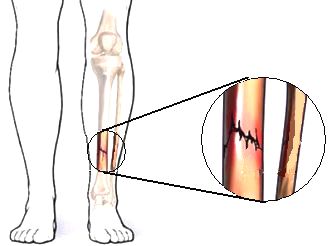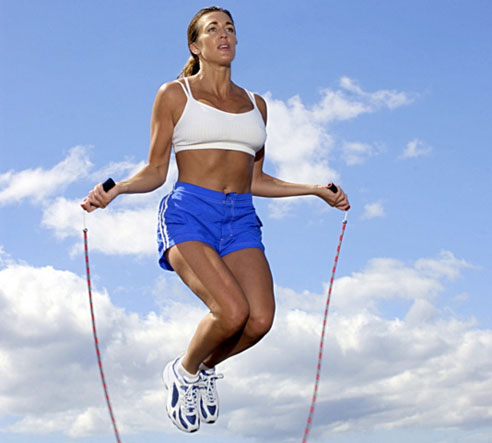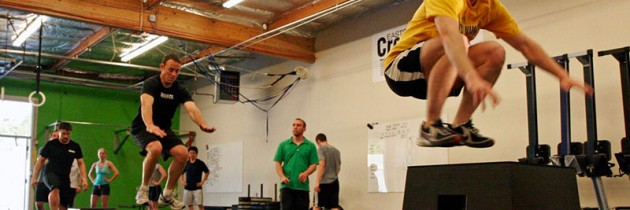Explosive Strength Training That Helps to Build Your Bones
For many years now our society has been focused on building stronger and more dense bones. As the population ages, it’s important to build up one’s bones early in life. Doing so will help stave off osteoporosis. Most people rely on supplements, such as calcium, Vitamin D and magnesium. While those will help somewhat, it’s physical movement that is really important.
Like our muscles, bones respond to the amount of resistance placed upon it. That response is further growth in strength and density. Realize that your bones are living tissues. Bones are also organs, like any other organ in your body. They store minerals, produce blood cells (red and white) and provide structural support for your body. See http://en.wikipedia.org/wiki/Bone for more information.
The higher the load placed upon both muscles and bones, the more both will build. Running will build bone more than static squats. Yes, lifting more weight in squats does help, still, running does trump doing squats for bone strength. The types of exercises does matter and is different in how they are done in different age brackets. According to E. Joan Bassey (2001), young women benefited from an increase in bone mass after one minute of jumping. Post-menopausal women did not. This was also previously shown in a 1998 study by E.J Bassey, et. al. Post-menopausal women need longer time periods to help increase bone strength and size.
Low impact exercises, such as walking and swimming, did not help with increasing bone density and strength.
For post-menopausal women who may be at risk for bone fractures, it’s important not to engage in high-impact activities. Instead, go for lower ones, such as jogging. Start off light and then increase incrementally to help build your bones up. Other exercises that can be done the same way are weight lifting and jumping. Just don’t do Parkour like I do. Heck, even I’m not going to jump off too high, like off a two-story building.
The thing about our bones, like our muscles, is that they tend to adapt to intensity and variety of impacts they endure (Vainionpää, et. al., 2007). This is especially true at the midpoint of the femur (upper leg bone and the largest in your body). The goal is to do a number of different impact exercises every day. That way you’re going to challenge your bones to adapt and to grow.

What About Stress Fractures?
When I was in boot camp in the Marines, stress fractures were common after vigorous physical training and force marches. We also ended up with stress fractures while doing some high impact exercises, such as dropping from some heights. This is true when the tibial has been trained to the point of being exhausted (Charles Milgrom, et. al, 2000). Furthermore, high impact exercises don’t strain the tibia anymore than running. Running can exhaust the supporting muscles in the lower legs and lead to an increase in stress on the bones.
In preventing stress fractures from occurring, one study (Lytt I.Gardner,Jr., et. al., 1988) showed that the right shock absorption footwear was needed. The study looked at Marine recruits from Parris Island, SC and found that their footwear and the heal snap cadence contributed to an increase in lower leg stress. More important, the study concluded that the physical conditioning of the lower legs was the biggest factor in preventing stress fractures.
A 2009 study by Kristin L. Popp, et. al. showed that one’s muscle size is related to whether or not a someone will suffer from stress fractures in the lower leg in the same activity. It’s important that athletes and the general public focus on building muscles size and strength in the lower legs. Not only will this help prevent stress fractures, it will also help overall physical performance, bone strength and increase (indirectly) bone growth in other areas. To build up lower leg strength, do exercises that engage the calves. Here are a few recommendations…

- Jumping rope. This is an explosive exercise with medium impact. It works out the calves as well as the rest of your body.
- Pogo jumps. You can do this one two ways. The first is lower impact. It’s much like doing the jumps of jumping rope without the rope. The second is more intense with higher jumps. You basically jump as high as you can using your ankles and calves. Alternative is the jump squat.
- Running stairs. This works the whole leg and a lot on the calves as the incline places more stress on them. Hill running will do the same thing, so will hiking up a hill.
- Sled drags. This is a rope or harness attached to a tire that you’re pulling.
- Single-legged calf raise. Standing with your toes on the edge of a curb or stairs, you simply raise your body using your ankle and calf.
Plyometric and Explosive Exercises/Training for Bone Growth and Strength
Overall, plyometric training is one of the best ways to help build both bone and muscle. It will help you prevent injuries to your bones and stave off osteoporosis. Medhat Kasem in 2010 presented a study that showed doing plyometric training helps increase bone mass in athletes between 13% and 19%. Additionally, bone injuries decreased by 42%.
Plyometric exercises also are great for building muscles. Your type 2 (fast twitch) muscle fibers get the most benefit from these type of exercises.
There are literally hundreds of ways to do plyometric exercises. And this article can’t even begin to explain how to do each one. So, in order to keep things simple for you, I’m going to give ones that you can do anywhere and they are easy to do. What is important before beginning any high impact jumping types of exercise is to first strengthen your lower legs. Here are a few plyometric exercises that I recommend…
- Box jumps. Do these by jumping onto the box (or bench) and jumping off. When landing, make sure to land on the balls of your feet and flex in your knees. Extend your arms in front for balance (if needed). Box heights can be increased as you progress, up to 42 inches.
- Pogo jumps (as explained in the previous section). You can start off on softer surfaces, such as on grass or a mat. Progress from there.
- Cone jumping. You’ll be jumping over cones set into a vertical row, one right after another.
- Bunny hops. Just like cone jumping, doing bunny hops helps to build bone strength. And they are fun too! Do them with your kids.
- Standing broad jumps. This is a more advanced jumping when your muscles are strong enough to handle the impact. I love doing them for my Parkour training.
Practice a couple of days a week with these exercises. There are YouTube videos that can help demonstrate each one. Most important it’s about progression. Depending on your level of fitness, don’t push yourself until you injure yourself. Again, make sure to build the muscles in your lower legs before beginning any high impact training program. I wish you the best in getting your bones (and muscles) strong, powerful and dense.
Cheers, Bob Choat

“Transformational Master Black Belt” America’s #1 Mind-Body Transformation Expert and author of Mind Your Own Fitness
bobchoat.com | optimallifeseminars.com
References
E.J. Bassey, M.C. Rothwell, J.J. Littlewood and D.W. Pye. “Pre- and Postmenopausal Women Have Different Bone Mineral Density Responses to the Same High-Impact Exercise.” Journal of Bone and Mineral Research 13 (1998) 1805-1813
E. Joan Bassey, “Exercise for prevention of osteoporotic fracture.” Age and Aging 3-S4 (2001) 29-31
Lytt I. Gardner, Jr., et. al. “Prevention of Lower Extremity Stress Fractures: A Controlled Trial of a Shock Absorbent Insole.” American Journal of Public Health 78 (1998) 1563-1567
Medhat Kasem. “Effectiveness of Shock Plyometric Training of Bone Density and Protection from Fractures Injury in Athletes.” World Journal of Sport Sciences 3 (2010) 01-06
Charles Milgrom, et. al. “Do high impact exercises produce higher tibial strains than running?” Journal of Sports Medicine 34 (2000) 195-199
Kristin L. Popp, et. al. “Bone Geometry, Strength, and Muscle Size in Runners with a History of Stress Fracture.” Medicine & Science in Sports & Exercise 41 (2009) 2145-2150 doi: 10.1249/MSS.0b013e3181a9e772
Aki Vainionpää, et.al. “Effect of impact exercise and its intensity on bone geometry at weight-bearing tibia and femur.” Bone 40 (2007) 604–611. doi:10.1016/j.bone.2006.10.005





